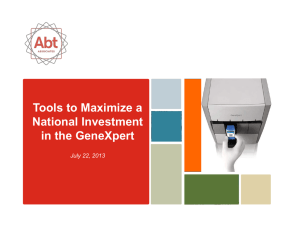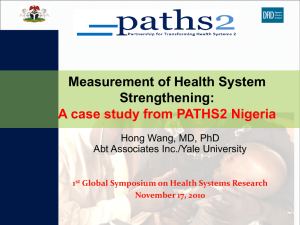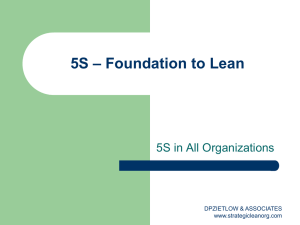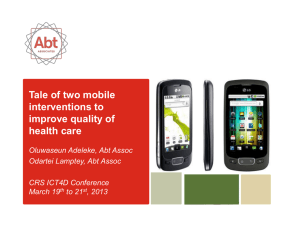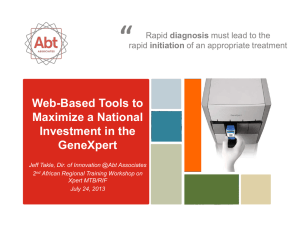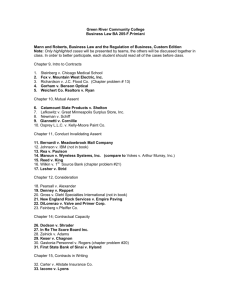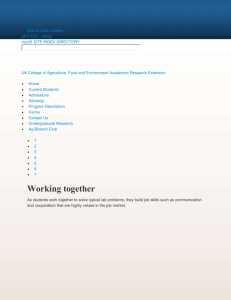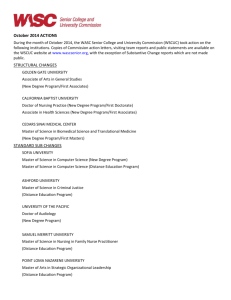Abt Associates' Labor Rates
advertisement
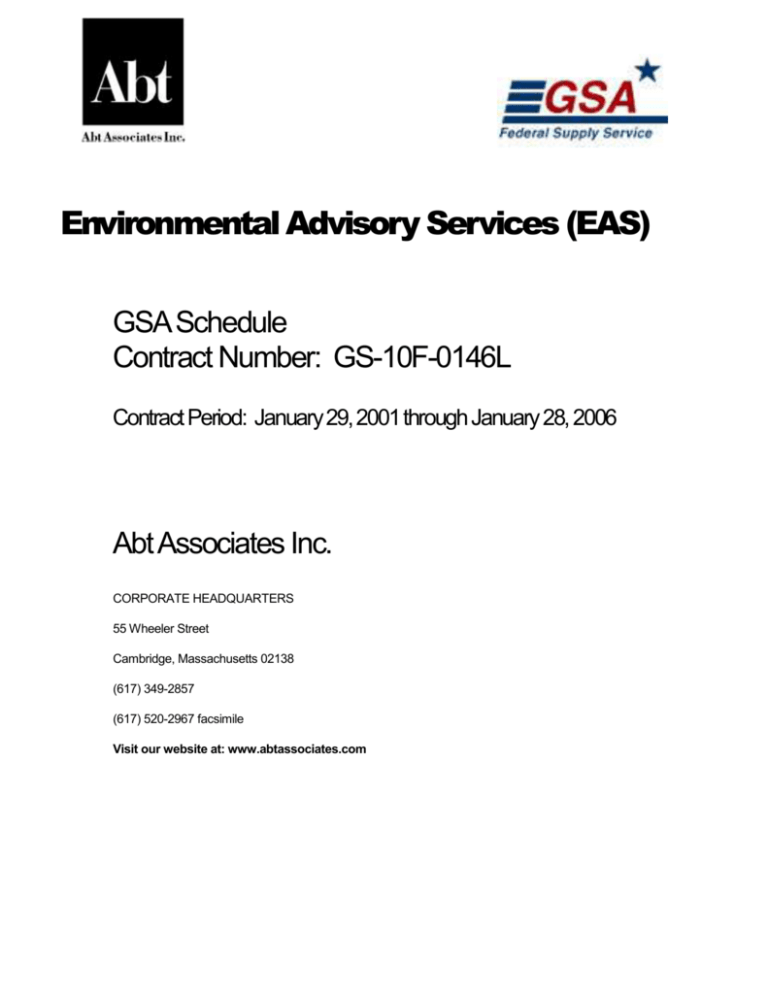
Environmental Advisory Services (EAS) GSA Schedule Contract Number: GS-10F-0146L Contract Period: January 29, 2001 through January 28, 2006 Abt Associates Inc. CORPORATE HEADQUARTERS 55 Wheeler Street Cambridge, Massachusetts 02138 (617) 349-2857 (617) 520-2967 facsimile Visit our website at: www.abtassociates.com Client Information for Ordering Activities GSA Schedule Contract Number: GS-10F-0146L Federal Supply Service Authorized Federal Supply Schedule Pricelist On-line access to contract ordering information, terms and conditions, up-to-date pricing, and the option to create an electronic delivery order is available through GSA Advantage!, a menu-driven database system. The INTERNET address for GSA Advantage! is http://www.gsa.gov. Industrial Group: 899 Industrial Class: 8999 Business Size: Large 1a Special Item Numbers (SINs): 899-1 Environmental Planning Services & Documentation 899-2 Environmental Compliance Services 899-4 Waste Management Services 899-6 Remote Advisory Services 899-7 Geographic Information Services 1b 2 Pricing for Services – see rate table inside this brochure Maximum Order: $1,000,000.00 3 Minimum Order: $300 4 Geographic Coverage: Worldwide 5 Point(s) of Production: N/A 6 Discount from List Prices or Statement of Net Price: Prices shown herein are net prices 7 Quantity Discounts: N/A 8 Prompt Payment Terms: Net 30 days 9 Government Commercial Credit Card: No 10 Foreign Items: None 11 Time of Delivery: Negotiated on Individual orders 12 13a F.O.B. Point(s): Destination Ordering address: Abt Associates Inc. Headquarters Office 55 Wheeler Street Cambridge, Massachusetts 02138 Attention: Sharon Christenson, Contact for Administration (617) 349-2857 Direct; (617) 520-2967 Facsimile sharon_christenson@abtassoc.com Abt Associates Inc. Washington D.C. Area Office 4800 Montgomery Lane, Suite 600 Bethesda, MD 20814 Attention: Mr. Daniel Weiss (301) 941-0275 Direct; (301) 652-7530 Facsimile 13b daniel_weiss@abtassoc.com BPA Ordering Procedures: The ordering procedures, information on Blanket Purchase Agreements, and a sample BPA can be found at the GSA/FSS Schedule homepage (fss.gsa.gov/schedules) 14 15 Payment address: Abt Associates Inc., PO Box 84-5586, Boston MA 02284-5586 Warranty Provisions: N/A 16 Export Packing Charges: N/A 17 Terms and Conditions of Government Commercial Credit Card: N/A 18-24 N/A 25 DUNS number: 04-339-7520 26 Central Contractor Registration (CCR): Abt Associates is registered in the CCR database Section 2 Abt Associates’ Labor Rates The government hourly rates (billable rates) for SINs 899-1, 899-2, 899-4, 899-6, and 899-7 are listed below by labor category and pertaining contract period. These billable rates have been adjusted to reflect the reduction in the Industrial Funding Fee to .75% effective 1/1/2004. Contract Base Period: January 29, 2001 through January 28, 2006 Labor Category Principal Environmental Specialist Senior Environmental Specialist Environmental Specialist Senior Environmental Analyst Environmental Analyst Associate Environmental Analyst Environmental Research Assistant Lead Environmental Programmer Senior Environmental Programmer Environmental Programmer Associate Environmental Programmer Contract Administrator Specialist Administrative Specialist 1/29/03 thru 12/31/03 $180.67 $152.18 $117.22 $98.52 $62.74 $52.46 $44.42 $131.71 $90.59 $68.03 $52.77 $94.06 $59.62 1/1/04 thru 1/28/04 $187.43 $157.88 $121.61 $102.20 $65.09 $54.42 $46.08 $136.64 $93.98 $70.57 $54.74 $97.58 $61.85 1/29/04 thru 1/28/05 $194.93 $164.19 $126.47 $106.29 $67.69 $56.60 $47.93 $142.10 $97.74 $73.40 $56.94 $101.48 $64.32 1/29/05 thru 1/28/06 $202.73 $170.75 $131.53 $110.54 $70.39 $58.86 $49.85 $147.79 $101.65 $76.33 $59.21 $105.54 $66.89 Section 3 The Abt Associates Advantage Founded in 1965 by Dr. Clark Abt, Abt Associates has achieved an international reputation for social and environmental policy research. For over three decades, Abt Associates has kept a sharp focus on providing quantitative, fact-based results to clients in government, foundations, associations, and businesses worldwide. One of the largest government consulting and research firms in the country, Abt Associates Inc. has experienced considerable growth and success over the past decade. In recent years, our annual revenues have exceeded $180 million. Our full-time permanent staff of over 1,000 includes nationally and internationally recognized experts known for their grasp of their respective disciplines, innovative research techniques, and insightful, and often groundbreaking, analyses and recommendations. Our headquarters are in Cambridge, MA. Abt Associates also has offices in Bethesda, MD, Washington, DC, Chicago, IL, and Amherst, MA. These locations provide Abt Associates advantages in terms of access to extraordinary academic research capabilities, particularly in the Boston and Washington DC areas, and ensures that the our staff is readily available to federal clients located in Washington DC. Abt Associates also has more than 20 project offices in Latin America, Africa, the Middle East, Asia, and the Newly Independent States. Abt Associates offers federal government clients and other eligible organizations a wide range of services through the GSA Environmental Advisory Services schedule: environmental planning and policy analysis, environmental risk assessment, and geographic information systems. Our environmental services are further augmented and strengthened by Abt Associates’ research in other key areas, including health economics, international economics and development, business strategy, survey research, and other social science fields. Special Item Number (SIN) 899-1: Environmental Planning Services and Documentation Economic Incentive Programs Global Climate Change Environmental Labeling Program Evaluation Environmental Outreach Institutional Strengthening Benefit Cost Analysis Non-market Valuation Methods Regulatory Impact Analysis Regulatory Flexibility Analysis Financial and Affordability Analyses Environmental Justice Analysis Monetizing Risk Reduction Benefits Cumulative Exposure Analysis Environmental Effects on Children’s Health Media and Pollutant-Specific Analyses Comparative Risk Assessment Fate and Transport Modeling Air Quality Impact Modeling Water Quality Impact Modeling Toxic Chemical Impact Modeling Environmental Information Policy Environmental Right-to-know Information Internet and Software Applications Environmental Survey Research Soil Conservation and Project Implementation Water Resource Management and Watershed Planning Assessing and Valuing Natural Resource Damages Environmental Impact Assessment The skills required for environmental planning projects are as diverse as the projects themselves. Thorough execution of such projects may include some, or all, of the following: identify, collect, develop, and interpret data; prepare human health risk and environmental impact evaluations; prepare regulatory and economic analyses; design and execute surveys; analyze comments; and prepare material for public meetings. We discuss Abt Associates’ qualifications under each of these topics in greater detail below. Risk evaluations Thorough assessments of multimedia risk and risk screenings provide essential information for setting environmental priorities, both at a facility level for individual company goals and at a national level to focus public policy development. Abt Associates can provide expertise in both human health and ecological risk assessments. For example, we have evaluated the human health and ecological risks associated with a "cluster" of pesticides now used on field corn, and compared potential risk reductions resulting from regulatory options. Going beyond previous registration-related pesticide analyses, this new approach simultaneously considered all herbicides and insecticides in the cluster and applied a consistent methodology for predicting risks from each. Abt Associates has also assessed the risks posed by wastes from the pulp and paper industry, sludge disposal, MTBE use, drinking water and ground water contamination, air pollution, and pesticide residue in food; and developed indicators to track the impacts of multimedia pollutant releases from the Toxics Release Inventory (TRI). We performed one of the first non-U.S. comparative risk assessments, in Bangkok, Thailand, to set environmental priorities for that city. Regulatory and economic analyses Economic Impact Analyses (EIAs) examine the economic and financial changes resulting from regulatory or nonregulatory policies or programs. While a benefit-cost analysis is concerned with whether the overall benefits justify new program costs, an EIA focuses on the program’s distributional effects and tries to answer questions of who gains and who loses from a policy and by how much. Impacts are typically analyzed for various affected groups that may include industries, governments, consumers, supplier, investors, and other stakeholders. Estimating benefits is another key component in evaluating any environmental initiative, program, or regulation consistently. One way to express the combined effect of multiple outcomes is to calculate and sum their values in monetary terms. Monetizing benefits also allows their comparison with the economic costs of a policy or program. Such regulatory and economic analysis underlies many of Abt Associates’ projects. Using a wide variety of tools, including economic models, physical effects models, databases, and spreadsheets, our staff is capable of sophisticated analyses related to cost analyses, market analyses, and other science policy and economic analysis applications. One example of our RIA and EIA experience is the TSCA Section 403 RIA and EIA. Under the Residential Lead-Based Paint Hazard Reduction Act of 1992, the Toxic Substances Control Act (TSCA) was amended, directing the U.S. Environmental Protection Agency (EPA) to undertake a number of regulatory, certification, and information dissemination actions relating to lead exposure reduction. Included among the requirements of these TSCA amendments is Section 403, Identification of Dangerous Levels of Lead, which requires the EPA Administrator to promulgate regulations that identify lead-based paint hazards, lead-contaminated dust, and lead-contaminated soil. Abt Associates Inc. is producing an Economic Impact Analysis (EIA) and a Regulatory Impact Analysis (RIA) of this rule for EPA. Both the EIA and the RIA present estimates of the economic benefits and costs of avoiding the risks posed to children from lead in residential paint, soil, and dust. We draw upon our earlier work, which constructed analytical framework models to estimate (1) the benefits of different lead abatement regulations, (2) the process of exposure over time and resulting damages, and (3) the effectiveness of alternative abatement scenarios. A key component of the EIA is a model that calculates the net benefits of alterative hazard standards, assuming that interventions occur at the time of greatest benefit, i.e., just before a child is born into the housing unit. This analysis identifies the standards yielding the maximum net benefits. The RIA extends this analysis to incorporate likely behavior on the part of property owners, under the assumption that they will not necessarily perform interventions at the most efficient time. Additional examples of the RIAs that Abt Associates has supported and/or drafted include: (1) Economic and Benefits Analysis of Clean Water Act (CWA) Section 316(b) Regulation of Cooling Water Intakes • Identified relevant subcategories for economic analyses • Developed financial and economic screener and detailed industry questionnaires. Responsible for all aspects of administering and managing the financial/economic parts of the detailed questionnaires • Developed detailed financial/economic profiles for the subject industries (Steam-electric utilities and non-utilities, and Paper and Allied Products, Chemicals and Allied Products, Petroleum and Coal Products, and Primary Metal Industries) • Responsible for conducting all economic analyses, including analyses required under Small Business Regulatory Enforcement Fairness Act (SBREFA) and Unfunded Mandates Reform Act (UMRA) • Studied effects of deregulation • Project will culminate in the development the Economic Analysis (EA) report for the 316(b) regulation (2) Economic Impact Assessment of the Effect of Effluent Limitations on the Pesticide Manufacturing and the Pesticide Formulating, Packaging, and Repackaging Industries • Identified relevant subcategories for rules • Developed and administered financial and economic industry questionnaires • Developed detailed financial/economic profiles for the subject industries • Conducted all economic analyses, including analyses required under the Regulatory Flexibility Act, required for the Economic Impact Analysis • Project culminated in the development of proposed and final Economic Impact Analysis (EIA) reports for the Pesticide Manufacturing and the Pesticide Formulating, Packaging, and Repackaging Industries (3) Technical and Regulatory Support for the Ground Water Rule • Conducted the economic analyses necessary to promulgate the proposed ground water rule (GWR). These analyses include national compliance cost modeling, household affordability analysis, regulatory flexibility and SBREFA analyses, and modeling of both health and nonhealth benefits resulting from the rule. • Developed the Ground Water Regulatory Analyses Tracking Model, or GREAT Model to allow EPA to see the distribution of compliance costs among drinking water systems in each system size/type category. The GREAT Model also included a module for modeling SBREFA and Regulatory Flexibility compliance. (4) Regulatory Impact Analysis of the Supplemental Proposed Rule for Reporting Pollution Prevention Act Required Information and to Redesign Form R • Estimated the costs and benefits to industry and government of expanding Form R to include the information required by the PPA, as well as the cost and benefits of issuing new guidance for the requirements of section 6607 of the PPA and of redesigning Form R. • Estimated costs the regulated community will incur to become familiar with the new guidance and the redesigned form, to develop estimates for the source reduction and recycling data elements as well as the new data elements added in the form redesign, to complete Form R, and to keep records. • Estimated costs EPA and states will incur to process the new source reduction and recycling data elements. Design and execute surveys Surveys can be used to collect economic, technical, organizational, and behavioral information to determine the possible effects of regulatory or non-regulatory policy options. They directly poll individual stakeholders in firms, industry groups, all levels of government, environmental groups, and the public, who may be affected by such policy options. Successful survey projects require expertise and experience in sample design, design of survey instruments, pretesting, survey organization and management, and survey data analysis. Sampling can range from the simplest random samples to extremely complex cluster and multisample designs. During our long history of designing effective samples that are both workable and that yield the data necessary to fulfill research objectives, Abt Associates has consistently met the challenge of balancing the statistics of pure research with the practical constraints of most projects. When designing survey instruments, we carefully check that items are unambiguous, unbiased, nonrepetitive, and properly sequenced, and that skip patterns are clear; and that answer categories are mutually exclusive and collectively exhaustive. Abt Associates has designed and administered surveys since the company’s inception nearly 35 years ago. Our survey projects during that time have included designing large-scale national sample surveys and small, local surveys. We conducted CDC’s National Immunization Survey, the largest government funded survey to date. Our survey research experts team with our clients to select the most appropriate type of survey and sampling method; develop survey instruments to minimize the potential for bias; and administer the surveys cost-effectively from our state-of-the-art Survey Research Center; and then work with our statisticians to analyze the results. This rigorous and proven approach develops meaningful results that stand up to public scrutiny. Our Survey Research Center conducts more than one million interviews annually, and frequently employs a Computer-Assisted Telephone Interviewing (CATI) system. Our work has included all methodological aspects of sample surveys including construction of sampling frames, stratification, sample size determination, allocation, and sample selection. Abt Associates is also a leader in Web-based surveys, including the development of advanced encryption methodologies and related statistical analyses. Examples of the range and type of surveys that have been conducted by Abt Associates’ Environmental Research Area follow: • Evaluation of the Massachusetts Toxics Use Reduction Program (TURP) - Abt Associates conducted and analyzed a telephone survey of all firms reporting under TURP, to determine how firms have implemented toxics use reduction, assess whether program goals are being met, support a cost-benefit analysis of the program, and guide future program improvements. • Pollution Prevention Motivation Survey - We designed this study to identify factors that affect businesses’ environmental performance and pollution prevention strategy implementation. The study included a survey of business and product-line managers in randomly selected printing companies and large manufacturers. • 1994 Office of Water Customer Satisfaction Survey - Abt Associates completed a customer satisfaction survey for EPA’s Office of Water (OW). OW used the survey results to examine its grant management practices, operations, and regulations as they affect three grant programs. The evaluation included a survey of states to assess customer satisfaction and to identify potential program improvements. • Toxic Release Inventory Non-Respondent Survey - Abt Associates conducted a survey of over 3,000 manufacturing facilities nationwide to determine compliance rates with reporting requirements under Section 313 of the Emergency Planning and Community Right-to-Know Act (EPCRA) and to assess reasons for noncompliance. We employed specialized interviewers with backgrounds in chemistry and chemical engineering. Data analysis Numerous and diverse sources of data might be relevant for any given environmental project. Knowing the best information sources, having the expertise to access and manage this information, understanding its limitations and strengths, and being able to present it in a usable format are critical qualifications for supporting tasks related to collecting and analyzing environmental data. We are particularly adept at using multiple sources of information and information collection tools in unique and creative ways to solve problems. For example, in a Survey Evaluation of Industry Motivation for Pollution Prevention, Abt Associates interviewed hundreds of industrial facility managers to understand their motivations for improving their environmental performance. We then used Environmental Protection Agency (EPA) databases to link their individual responses to their facility’s Toxics Release Inventory releases, facility characteristics, and compliance and enforcement records. In doing so, we were able to analyze the relationships among actual trends in environmental performance, inspections and enforcement actions, reported motivations for improved environmental performance, facility size, and industry sector. Some projects require widespread data collection, but sometimes the only way to get accurate and independent information is through first-hand information-gathering at facilities. On-site visits can be invaluable in better understanding the drivers and barriers affecting a facility’s or an industry’s environmental performance. Abt Associates’ on-site information collection has ranged from gathering performance, cost, and risk data on specific industrial processes at more than 100 facilities, to conducting interviews with construction contractors, designers, EPA management, and furniture and wall manufacturers involved with renovating EPA’s offices using green building concepts. Analyze comments In any forum where stakeholders are given an opportunity to submit comments, it is critical to establish a system that lets those commenting know that their input was considered in the process. Such a system leads to a balanced final decision, increased trust among participants, and improved acceptance of the final outcome. Additionally, systematic and meaningful consideration of comments can help avoid future adversarial relationships or litigation. Abt Associates has worked extensively on summarizing and analyzing public comments. For example, for the review of the standards for particulate matter and ozone, we summarized over 40,000 written public comments. To handle this unprecedented volume of comments effectively, we developed a sophisticated Windowsbased computer application known as CaRT (the Comments and Response Tracking system) to identify.and organize each issue raised in the comments. Our staff also reviewed all written comments and summarized each issue addressed. In so doing, we identified and classified issues on every aspect of the two standards. By using a database approach to organize the public comments, Abt Associates was able to produce separate final reports organized by topic, author, and specific rule. We also produced interim special reports and an analysis of the overall “for or against” positions of the commenters. Prepare for public meetings Abt Associates’ experience assisting the EPA in a variety of public forums has given us the necessary skills to prepare information thoroughly and to deal effectively with potentially adversarial groups. One key component of a successful and productive meeting is a skilled facilitator who understands both the technical concepts and the motivators of different participants. For example, Abt Associates provided the meeting facilitator for a public hearing announcing the intended launch of an innovative project to provide public access to facility-level environmental information. We have provided similar public hearing support at various stages of several rulemaking efforts and critical stakeholder meetings to discuss pollution prevention strategies. Some of the facilitation involves meeting and working cooperatively with individuals and organizations interested in particular Agency activities and initiatives. We recently completed our support for a planning group, made of many different stakeholder groups, in a project dealing with completely revamping the permitting process for small printers. International environmental planning support Abt Associates has provided environmental planning services to support specific development projects, as well as to support better environmental management by local and national governments. For example, we evaluated strategies for environmental institutional strengthening and legal reforms, use of economic incentives, and environmental actions as part of a project to protect the Río Grande de Tárcoles watershed. The resulting studies provide the basis for future planning of environmental activities in the region. Abt Associates also developed a multisectoral management plan for the Government of Nicaragua to improve human health, well-being and water quality in the southern watershed of Lake Managua. In India, we worked with local entities to develop improvement plans for urban waterways in two cities. We also developed an integrated environmental management strategy and implementation plan for Tegucigalpa, Honduras. This comprehensive environmental management strategy for the Municipality of Tegucigalpa addressed a broad range of environmental management issues, including (a) an institutional process for auditing municipal facilities, (b) requirements for environmental impact assessments (EIAs) and their specifications, (c) EIA preparation, (d) environmental standards and criteria from the EIA, and (e) monitoring. We developed a detailed action plan outlining activities, personnel, time-line, and budget for implementing the proposed strategy. The Government of Bolivia has recently contracted Abt Associates to design an environmental action plan for the oil and gas sector. This plan will include elements to address potential impacts on protected areas and indigenous populations, institutional roles at the national and local level, public participation, and geographic and other information systems. Special Item Number (SIN) 899-2: Environmental Compliance Services Voluntary Environmental Programs Environmental Right-to-know Information Industry Profiles Design for the Environment Pollution Prevention Programs Environmental Performance Measures Industry and Sector Initiatives With frequent changes to environmental regulations and their interpretation at the federal, state, and local levels, the regulated community often seeks the advice of outside sources to assist its members in maintaining or achieving compliance. Analyzing the sector- or facility-specific impact of pending regulations also helps regulated facilities plan for future opportunities to achieve or go beyond environmental compliance. Environmental Compliance Audits Environmental audits can help regulated industries comply with environmental laws and shift states’ limited enforcement resources into areas of greater concern. An environmental audit is a voluntary internal evaluation of a facility’s overall operations or specific processes. Companies use them to measure compliance with environmental regulations, identify problems early and correct them quickly, provide assurance that pollution control systems function properly, and make the company’s overall environmental program more pro-active. Some states have enacted or adopted, and other states are considering, legislation or policies to encourage greater use of environmental audits. The legislation typically grants a company limited immunity from fines and penalties if it voluntarily discloses the audit results and corrects the violation in a timely manner. Company information generated through an audit also receives a privilege against disclosure in an administrative or judicial proceeding. For the National Conference of State Legislatures (NCSL), Abt Associates designed and conducted a survey to evaluate the effects of state voluntary environmental audit privilege and immunity legislation. The project aimed to determine whether more and better environmental audits are being conducted in those states that have passed legislation than in those states that have not passed legislation, and whether corrective actions for reported violations are being undertaken more quickly than would have otherwise occurred. Abt Associates developed the survey instrument, designed and collected the survey sample, and administered the survey via telephone to nearly 1,000 respondents in regulated industrial facilities. After the survey administration was completed, Abt Associates coded, cleaned, and weighted the data, and calculated 95% confidence intervals using statistical analysis software. We analyzed the results to identify factors affecting self-audits as they apply to the objectives of the project. Abt Associates is currently assisting EPA's National Environmental Performance Track (NEPT) program. NEPT is a voluntary program, launched in June 2000. NEPT recognizes and rewards facilities that achieve better environmental performance than is required under existing regulations. Abt Associates is assisting NEPT in developing tools and methods to successfully implement the program. First, we are developing a site visit protocol and guidance. We prepared a draft protocol based on the program requirements, and then tested this protocol by accompanying EPA on several site visits. Based on these site visits, we modified the protocol to produce a final document (including instructions) that will be used in all Regions for all site visits conducted. Second, we are developing appropriate enforcement screening tools to assist the program in evaluating applicants' compliance history. Compliance Management Planning With the recently established ISO 14001 standards, many businesses are considering implementing an Environmental Management System (EMS). An EMS provides a systematic way to review and improve operation for better environmental compliance and overall performance. With an EMS, a company has the tools and administrative procedures to incorporate environmental considerations into its daily decision-making process. The five main stages of an EMS, as defined by the ISO 14001 standard, are (1) establishing an environmental policy, (2) planning, (3) implementation and operation, (4) checking and corrective action, and (5) management review. ISO standards provide guidelines on EMS design, but do not necessarily move a company toward the intended benefit of continuous environmental improvement. For EPA’s Design for the Environment (DfE) Program, Abt Associates developed a manual aimed at filling this gap. The manual shows smalland medium-sized businesses how the DfE concepts of weighing trade-offs among the cost, performance, and risks of a product or process fit into the ISO 14001 EMS. The manual is now being used in pilot projects with eight volunteer manufacturing facilities as they implement an EMS that incorporates the DfE concepts. Abt Associates continues to support this project by conducting DfE/EMS training for the pilot facilities and writing several case studies on the project. For the Office of Policy, Planning, and Evaluation, Abt Associates prepared a literature review of current environmental performance measures. The review evaluated ISO’s 14031 Environmental Performance Evaluation standards, tools such as life cycle analysis and total cost accounting, and regulatory requirements, including the New Jersey Non-product Output method and the Massachusetts Toxics Use Reduction Act data collection requirements. In addition to these sources, selected corporate environmental reports were examined to determine what measures were included and how they were presented. Using the information from the literature search, Abt Associates developed both a background paper on environmental performance measures and a prototype measurement system that was discussed at a workshop of stakeholders representing industry, regulators, and community members. The outcome of the workshop was a revised measurement system tested at three facilities. At a second workshop, Abt Associates discussed the field test results with industry, government, and community stakeholders. Our final product, an Environmental Performance Measures Tool-kit, provided a menu of measures with guidance and analysis on when and how they should be used. As part of EPA’s Common Sense Initiative for Metal Finishing, Abt Associates also developed measures for tracking metal finishers’ progress towards pollution prevention goals at the facility level. The measures were incorporated into a worksheet that will be completed annually by participating facilities. Pollution Prevention Surveys Over the past decade, companies of all sizes and in all industries have found that implementing pollution prevention projects helped them reduce their environmental impact while also reducing their costs. At the core of pollution prevention theory is the assumption that any waste can signal process inefficiencies. An inefficient use of resources therefore becomes an avoidable cost. Reducing or eliminating the creation of wastes at the source where they are generated reduces environmental impact and costs. Recognizing these benefits, Congress passed the federal Pollution Prevention Act in 1990. Several states have promulgated their own pollution prevention regulations. For example, some states require facilities to develop Pollution Prevention Plans, whereby each facility must identify pollution prevention opportunities and evaluate their economic and technical feasibility. Abt Associates staff members have been trained and/or certified to assist companies with this type of analysis. Massachusetts’ Toxics Use Reduction Act (TURA) is one state law that requires Pollution Prevention Plans. A full evaluation of TURA, in effect since 1989, was recently completed. The state contracted with Abt Associates to conduct a survey of the regulated community and to analyze and report the results, including a benefit-cost analysis. Staff from Abt Associates’ Environment group developed the survey questions to collect data needed to evaluate the program’s impact. Our Survey Research Group, scrutinized the survey to reduce any bias. Our Survey Research Center pre-tested and thenadministered the survey via our ComputerAssisted Telephone Interviewing (CATI) system. This automated system allowed responses to be entered directly into a database to minimize errors. We used a fax-back form to collect quantitative data on the costs and benefits. We delivered results, including a bias analysis and an evaluation of statistical correlations, in both a written report and an oral presentation. Our final report also included analysis of specific and overall program costs and benefits. For EPA, Abt Associates conducted a nationwide survey designed to obtain sound information on the many factors influencing business decisions that affect environmental performance and industry implementation of pollution prevention practices. Federal agencies and others have used the resulting information to direct policies and programs that promote pollution prevention and improved facility performance. We administered the survey to business and product line managers (rather than environmental affairs specialists) at more than 1,000 randomly-selected companies. The sampling strategy and survey design provided the client with statistically valid results at the national level. In an innovative step, several analyses linked the survey responses to independent data sources, such as inspection and enforcement action history and TRI waste generation reporting. Abt Associates was responsible for all aspects of survey development and administration, including sample selection; survey instrument preparation; pretest and revisions; survey administration; survey protocols; analysis of possible non-respondent bias; post-survey weighting; and the linkage of independent information, such as inspection and enforcement history, TRI waste generation rate changes, and employment. Special Item Number (SIN) 899-4: Waste Management Services Feasibility Studies Global Climate Change Cumulative Exposure Analysis Environmental Effects on Children’s Health Media and Pollutant-Specific Analyses Comparative Risk Assessment Fate and Transport Modeling Air Quality Impact Modeling Water Quality Impact Modeling Toxic Chemical Impact Modeling The services associated with waste management projects include performing waste characterization; making recommendations regarding waste management practices; and developing options for recycling, such as waste collection and transfer, source reduction, and options for energy and fuel use. Abt Associates provides a wide variety of innovative, effective applications of scientific, analytical, and research expertise and support in the area of waste management. We have used diverse analytical approaches to perform waste characterization, analyze impacts of regulations, evaluate existing waste management practices, examine risk tradeoffs among policy options, and develop waste management guidelines. To support these services, Abt Associates has extensive capabilities required for managing and performing risk, exposure, and hazard assessments; preparing a broad spectrum of regulatory analyses; and analyzing comments from stakeholder groups. Below we describe the type of waste management services Abt Associates has conducted, as well as additional supporting capabilities. Hazard, exposure, and risk assessments Abt Associates frequently performs complex, comprehensive risk exposure and hazard assessments, using complex and innovative analytic methods. These assessments evaluate environmental contaminations of industrial waste streams and support the development of numerous regulations, guidelines, and standards. Our projects characteristically involve integrating information and approaches across many different disciplines and environmental media, and designing creative methodologies to address highly complex problems. Abt Associates has also provided support to EPA and other agencies in developing methods to evaluate risk for newly emerging concerns including the impact of endocrine disruptors on aquatic life, prenatal exposures to toxins and birth outcomes, and other topics. Abt Associates has supported the Office of Water for over ten years by performing risk assessments and other analyses required to develop regulations and analyze potential benefits of regulating municipal biosolids use and disposal. Highlights of this work include developing numerical criteria for biosolids disposal options, by estimating human exposure and aggregate population risks through volatilization, groundwater, and surface water pathways for 15 contaminants. For this project, Abt Associates developed original methods for estimating exposure and risks from sewage sludge incineration. Abt Associates also conducted a comprehensive hazard identification and screening of pollutants in biosolids by performing a comprehensive environmental assessment, including in-stream modeling of pollutants and human exposure estimates, to determine which pollutant candidates should be proposed for possible regulation in a second round of rulemaking. Abt Associates has developed the Risk-Screening Environmental Indicators model, which supplements a quantity-based (“pounds only”) view of TRI releases by incorporating information and models that assess, at a screening-level, the risk-related trends that chemical releases may pose. The information and models enable the user to consider the toxicity of chemicals, the quantity to which people are exposed, and the size of the population exposed to those chemicals. The model compares riskrelated impacts of particular chemicals, industries, and geographic regions, thereby allowing EPA and other users to establish priorities for improving future environmental health. Waste Management Plans/Feasibility Studies To make sound waste management recommendations, feasibility studies may be required to identify and evaluate possible solutions. For EPA’s Industrial Combustion Coordinated Rule (ICCR), the Agency combined all the industrial-commercial-institutional combustion sources into one rulemaking effort to maximize environmental and public health benefits while reducing the burden of compliance with the new emission standards. Abt Associates assisted EPA in developing technical and regulatory strategies to reduce pollutants for industrial combustors. Pollution prevention metrics, fuel/waste constituent limits, fuel/waste standards with de minimus level, waste accounting and record keeping, and work practice standards were among the options developed. We analyzed and presented the feasibility of each option, and reviewed all options for possible incorporation into the rule. Special Item Number (SIN) 899-6: Remote Advisory Services Regulatory Impact Analysis Regulatory Flexibility Analysis Industry Profiles Design for the Environment Pollution Prevention Programs Environmental Performance Measures Industry and Sector Initiatives Remote Advisory services are an essential service for organizations and agencies that have any significant interactions with the regulated community, the public, or other stakeholders. These services are among the most effective means of providing critical information to the targeted audience in a timely manner. Abt Associates’ experience spans the range of remote advisory services, such as telephone hotlines, information request fulfillment, providing and interpreting MSDS information for specific applications, and providing and interpreting regulatory requirements for specific circumstances. We describe below the type of remote advisory services we have conducted, along with additional supporting capabilities. Material Safety Data Sheets (MSDS) Material safety data sheets provide basic information needed to ensure the safety and health of the user at all stages of its manufacture, storage, use, and disposal. Abt Associates has provided support to EPA's Office of Pollution, Prevention and Toxics in it's Design for the Environment (DfE) Program, which helps businesses incorporate environmental considerations into the design and redesign of products, processes, and technical and management systems. As part of numerous DfE projects, Abt Associates evaluated industry technologies, detailing chemical use and comparing relative, health, environmental, and safety concerns for each existing industrial process. We also prepared a variety of outreach tools, including material safety fact sheets, bulletins, and pollution prevention case studies. Information Hotlines Information hotlines serve stakeholders’ interests by providing up-to-date and accurate information and providing an avenue for interested parties to give their direct response to issues of concern. Abt Associates has considerable experience in the use of information hotlines for use by the general public and specific industry sectors. For example, under contract to EPA's Office of Enforcement and Compliance Assurance, we established and now staff during all business hours an information hotline for the Sector Facility Indexing Project. The hotline has been the primary portal used by facility staff to get more information about the facility data used in the project. The hotline also allows EPA to gather valuable feedback from users through their comments and questions, and also allows facilities to propose changes for their compliance information. Environmental Regulations Abt Associates readily incorporates its thorough understanding of environmental statutes to evaluate critical impacts of facility-level, industry-wide, or national regulatory changes. Our staff has utilized its regulatory expertise for EPA in preparing numerous sectorspecific digests of environmental regulations for both EPA's Office of Compliance Industry Sector Notebooks project and its Office of Pollution Prevention and Toxics, Design for the Environment (DfE) Program. Special Item Number (SIN) 899-7: Geographic Information Systems (GIS) Internet and Software Applications Soil Conservation and Project Implementation Water Resource Management and Watershed Planning Environmental Impact Assessment Much of the data involved in developing, analyzing, and enforcing EPA regulations have an inherent geographic component. Geographic information systems (GIS) have a unique ability to (1) display data based on their geographic elements, and (2) manipulate and analyze those elements according to the latest geographic and cartographic principles. Below, we describe our broad range of analyses using GIS. Mapping and cartography GIS has the fundamental capability of displaying information graphically for clear presentation and interactive data exploration. A map can easily illustrate the physical associations among such disparate features as pollution point sources, affected water bodies or other impacted environmental features, and the population characteristics of the surrounding areas. Maps are also useful for quickly illustrating where and to what degree the economic impacts of proposed regulation will be felt, or where regulatory enforcement actions are concentrated and which areas need more attention. Additionally, GIS facilitates changes in categorization, symbolization, scale, and attributes displayed, allowing exploration of patterns that reveal themselves in the data. Abt Associates has produced report-quality maps for a wide range of projects. For example, our staff produced a series of maps illustrating the potential benefits of proposed Metal Products and Machinery regulations for affected water bodies. The maps depicted how facilities used in the analysis cluster geographically around specific water bodies, the proximity of facilities to water-related recreational sites, and how water bodies that would benefit from the proposed regulation are situated in areas of high population. These maps were designed using the latest cartographic principles for inclusion in the report delivered to EPA. Spatial modeling The science of geography has developed many tools that are implemented by or that make use of GIS technology, and which may be applied to a considerable number of EPA analyses. Spatial statistics have been developed that measure such things as spatial clustering and the degree of spatial association among features of interest. Kriging and other interpolation methods are available to produce continuous surface models for a wide range of applications. Kriging is a sophisticated spatial interpolation method that fills in the "missing" values of a continuous surface (like a contour map) from a collection of individual data points. The method estimates the value at any unsampled point using a weighted linear combination of the available data that minimizes the mean residual error, and is distinguished from other linear interpolation methods (i.e,. most methods) because it also minimizes the error variance. Distance decay models can be developed on a case-by-case basis to measure pollution point source impacts or other range-of influence-types of effects. Attribute values can be assigned to one set of features based on their proximity to another set that has the desired information, and distance variables can be created based on the measure of that proximity. Abt Associates staff members are utilizing these capabilities to allocate the impacts of groundwater contaminated with MTBE to the attributable sources for EPA’s Office of Pollution Prevention and Toxics. MTBE is a chemical compound used as a fuel additive in gasoline to meet the Reformulated Gasoline (RFG) requirements of the Clean Air Act. MTBE dissolves and spreads in the groundwater more easily than other components of gasoline, however; does not degrade easily; and is difficult and costly to remove from groundwater. We are developing stochastic spatial models relating MBTE groundwater contamination levels; drinking water point sources, such as wells and water treatment facilities; and possible contamination sources in the form of above-ground and underground gasoline storage tanks. Site selection GIS spatial modeling functions are particularly well suited for analyses involving characterizing and identifying desirable locations for a range of activities. The decision process used to select potential locations typically involves the consideration of many different criteria. GIS have the unique ability to analyze all the factors under consideration in terms of their geographic references; that is, how they vary over space and what their values are at any given point. Additionally, GIS can measure and compare the degrees of access to individual locations by a site's potential users. Our staff members have used this type of information to build complex spatial models to identify such things as ecological zoning restrictions for potential sites of hydrocarbon development in Central America. Spatial decision support systems GIS form is the most critical components of an effective spatial decision support system (SDSS). GIS support the spatially-sensitive integration of biophysical and economic modeling. As flexible analysis tools, SDSSs, integrate software for accessing, retrieving, and generating reports on simulation and decision models and database information. Policy and costbenefit analysis, spatial sensitivity, and alternative testing can be achieved using GIS in an SDSS environment. For example, Abt Associates staff members have used SDSS for watershed assessment, management, and policy evaluation. They assessed least-cost effective nonpoint source pollution control strategies in terms of equity, effectiveness, and policy adoption risk. We are in the process of upgrading a watershed SDSS used for prior projects. Web-based GIS applications More and more spatial information is becoming available on the World Wide Web each day. Government agencies, advocacy groups, and other sectors are implementing Web-based GIS applications to assimilate and display information conveniently and efficiently online. Maps are often a more useful method for distributing information to users than are tables and graphs. Abt Associates staff has experience developing Web pages that are integrated with GIS for environmental problem solving, data manipulation, and displaying various environmental and human health impacts.
